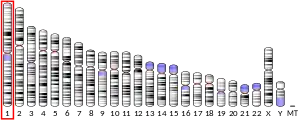NFASC
Neurofascin is a protein that in humans is encoded by the NFASC gene.[5][6][7]
Function
Neurofascin is an L1 family immunoglobulin cell adhesion molecule (see L1CAM) involved in axon subcellular targeting and synapse formation during neural development.[7][8]
Clinical importance
A homozygous mutation causing loss of Nfasc155 causes severe congenital hypotonia, contractures of fingers and toes and no reaction to touch or pain.[9]
References
- GRCh38: Ensembl release 89: ENSG00000163531 - Ensembl, May 2017
- GRCm38: Ensembl release 89: ENSMUSG00000026442 - Ensembl, May 2017
- "Human PubMed Reference:". National Center for Biotechnology Information, U.S. National Library of Medicine.
- "Mouse PubMed Reference:". National Center for Biotechnology Information, U.S. National Library of Medicine.
- Volkmer H, Hassel B, Wolff JM, Frank R, Rathjen FG (July 1992). "Structure of the axonal surface recognition molecule neurofascin and its relationship to a neural subgroup of the immunoglobulin superfamily". The Journal of Cell Biology. 118 (1): 149–61. doi:10.1083/jcb.118.1.149. PMC 2289533. PMID 1377696.
- Burmeister M, Ren Q, Makris GJ, Samson D, Bennett V (July 1996). "Genes for the neuronal immunoglobulin domain cell adhesion molecules neurofascin and Nr-CAM map to mouse chromosomes 1 and 12 and homologous human chromosomes". Mammalian Genome. 7 (7): 558–9. doi:10.1007/s003359900168. PMID 8672144. S2CID 29190292.
- "Entrez Gene: NFASC neurofascin homolog (chicken)".
- Ango F, di Cristo G, Higashiyama H, Bennett V, Wu P, Huang ZJ (October 2004). "Ankyrin-based subcellular gradient of neurofascin, an immunoglobulin family protein, directs GABAergic innervation at purkinje axon initial segment". Cell. 119 (2): 257–72. doi:10.1016/j.cell.2004.10.004. PMID 15479642. S2CID 16245348.
- Smigiel R, Sherman DL, Rydzanicz M, Walczak A, Mikolajkow D, Krolak-Olejnik B, Kosinska J, Gasperowicz P, Biernacka A, Stawinski P, Marciniak M, Andrzejewski W, Boczar M, Krajewski P, Sasiadek MM, Brophy PJ, Ploski R (August 2018). "Homozygous mutation in the Neurofascin gene affecting the glial isoform of Neurofascin causes severe neurodevelopment disorder with hypotonia, amimia and areflexia". Human Molecular Genetics. 27 (21): 3669–3674. doi:10.1093/hmg/ddy277. PMC 6196652. PMID 30124836.
Further reading
- Hortsch M (October 1996). "The L1 family of neural cell adhesion molecules: old proteins performing new tricks". Neuron. 17 (4): 587–93. doi:10.1016/S0896-6273(00)80192-0. PMID 8893017. S2CID 9625203.
- Nakajima D, Okazaki N, Yamakawa H, Kikuno R, Ohara O, Nagase T (June 2002). "Construction of expression-ready cDNA clones for KIAA genes: manual curation of 330 KIAA cDNA clones". DNA Research. 9 (3): 99–106. CiteSeerX 10.1.1.500.923. doi:10.1093/dnares/9.3.99. PMID 12168954.
- Tuvia S, Garver TD, Bennett V (November 1997). "The phosphorylation state of the FIGQY tyrosine of neurofascin determines ankyrin-binding activity and patterns of cell segregation". Proceedings of the National Academy of Sciences of the United States of America. 94 (24): 12957–62. Bibcode:1997PNAS...9412957T. doi:10.1073/pnas.94.24.12957. PMC 24245. PMID 9371782.
- Ren Q, Bennett V (May 1998). "Palmitoylation of neurofascin at a site in the membrane-spanning domain highly conserved among the L1 family of cell adhesion molecules". Journal of Neurochemistry. 70 (5): 1839–49. doi:10.1046/j.1471-4159.1998.70051839.x. PMID 9572267.
- Zhang X, Davis JQ, Carpenter S, Bennett V (November 1998). "Structural requirements for association of neurofascin with ankyrin". The Journal of Biological Chemistry. 273 (46): 30785–94. doi:10.1074/jbc.273.46.30785. PMID 9804856.
- Nagase T, Ishikawa K, Suyama M, Kikuno R, Miyajima N, Tanaka A, Kotani H, Nomura N, Ohara O (October 1998). "Prediction of the coding sequences of unidentified human genes. XI. The complete sequences of 100 new cDNA clones from brain which code for large proteins in vitro". DNA Research. 5 (5): 277–86. doi:10.1093/dnares/5.5.277. PMID 9872452.
- Koroll M, Rathjen FG, Volkmer H (April 2001). "The neural cell recognition molecule neurofascin interacts with syntenin-1 but not with syntenin-2, both of which reveal self-associating activity". The Journal of Biological Chemistry. 276 (14): 10646–54. doi:10.1074/jbc.M010647200. PMID 11152476.
- Ratcliffe CF, Westenbroek RE, Curtis R, Catterall WA (July 2001). "Sodium channel beta1 and beta3 subunits associate with neurofascin through their extracellular immunoglobulin-like domain". The Journal of Cell Biology. 154 (2): 427–34. doi:10.1083/jcb.200102086. PMC 2150779. PMID 11470829.
- Jenkins SM, Kizhatil K, Kramarcy NR, Sen A, Sealock R, Bennett V (November 2001). "FIGQY phosphorylation defines discrete populations of L1 cell adhesion molecules at sites of cell-cell contact and in migrating neurons". Journal of Cell Science. 114 (Pt 21): 3823–35. PMID 11719549.
- Jenkins SM, Bennett V (November 2001). "Ankyrin-G coordinates assembly of the spectrin-based membrane skeleton, voltage-gated sodium channels, and L1 CAMs at Purkinje neuron initial segments". The Journal of Cell Biology. 155 (5): 739–46. doi:10.1083/jcb.200109026. PMC 2150881. PMID 11724816.
- Charles P, Tait S, Faivre-Sarrailh C, Barbin G, Gunn-Moore F, Denisenko-Nehrbass N, Guennoc AM, Girault JA, Brophy PJ, Lubetzki C (February 2002). "Neurofascin is a glial receptor for the paranodin/Caspr-contactin axonal complex at the axoglial junction". Current Biology. 12 (3): 217–20. doi:10.1016/S0960-9822(01)00680-7. PMID 11839274. S2CID 18017227.
- Kizhatil K, Wu YX, Sen A, Bennett V (September 2002). "A new activity of doublecortin in recognition of the phospho-FIGQY tyrosine in the cytoplasmic domain of neurofascin". The Journal of Neuroscience. 22 (18): 7948–58. doi:10.1523/jneurosci.22-18-07948.2002. PMC 6758080. PMID 12223548.
- Gollan L, Salomon D, Salzer JL, Peles E (December 2003). "Caspr regulates the processing of contactin and inhibits its binding to neurofascin". The Journal of Cell Biology. 163 (6): 1213–8. doi:10.1083/jcb.200309147. PMC 2173730. PMID 14676309.
This article is issued from Wikipedia. The text is licensed under Creative Commons - Attribution - Sharealike. Additional terms may apply for the media files.






